INSTITUT SUPERIEUR D'ANTHROPOLOGIE
INSTITUTE OF ANTHROPOLOGY
ONLINE COURSES / COURS A DISTANCE
DEBUT COURS : AVRIL 2023
REGISTER NOW
TURQUIE – 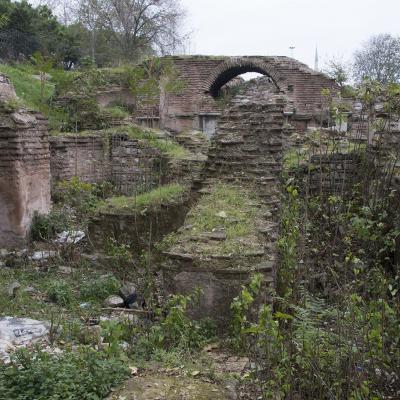
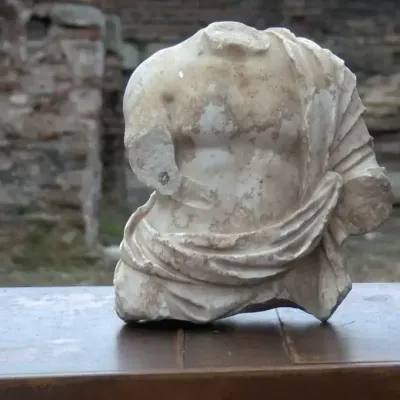 Saraçhane - At Saraçhane Archaeology Park, where the Church of St. Polyeuctus is situated, excavation work by Istanbul Metropolitan Municipality (IBB) teams found a statue that is thought to date back to the Roman era. There are modest ruins of a structure that was once the largest church in Constantinople and was constructed to resemble the Solomon Temple in Jerusalem in a small park right in the middle of Istanbul’s Fatih neighborhood. Before the erection of the new Hagia Sophia by Emperor Justinian in 537, the Church of Saint Polyeuctus was the largest temple in Constantinople. Although only ruins remain from the church, it is very important in terms of shedding light on an important period in Byzantine history. The church was built by Anicia Juliana, daughter of Olybrius, a former Western Roman emperor. The church, which was the most magnificent structure of Constantinople in the years it was built, was dedicated to a Christian martyr named Saint Polyeuctus. The Church of St. Polyeuctus, built in A.D. 524 was destroyed after being used for various purposes. However, after some historical artifacts belonging to the church were discovered during the construction of an underpass in the 1960s, excavation works were carried out in the church. Following a six-year hiatus, excavation work was resumed by IBB Heritage teams affiliated with the Cultural Affairs Directorate. A statue was discovered approximately 1 meter (3 feet) deep in the fill on the north side of the main structure where excavation work was being done. The marble statue’s head, legs, and right arm were found to be broken at shoulder height. The figure, dressed in a himation that exposes the upper right side of its body, is thought to date from the Roman period. The exact age and period of the statue will be determined after further examination.
Saraçhane - At Saraçhane Archaeology Park, where the Church of St. Polyeuctus is situated, excavation work by Istanbul Metropolitan Municipality (IBB) teams found a statue that is thought to date back to the Roman era. There are modest ruins of a structure that was once the largest church in Constantinople and was constructed to resemble the Solomon Temple in Jerusalem in a small park right in the middle of Istanbul’s Fatih neighborhood. Before the erection of the new Hagia Sophia by Emperor Justinian in 537, the Church of Saint Polyeuctus was the largest temple in Constantinople. Although only ruins remain from the church, it is very important in terms of shedding light on an important period in Byzantine history. The church was built by Anicia Juliana, daughter of Olybrius, a former Western Roman emperor. The church, which was the most magnificent structure of Constantinople in the years it was built, was dedicated to a Christian martyr named Saint Polyeuctus. The Church of St. Polyeuctus, built in A.D. 524 was destroyed after being used for various purposes. However, after some historical artifacts belonging to the church were discovered during the construction of an underpass in the 1960s, excavation works were carried out in the church. Following a six-year hiatus, excavation work was resumed by IBB Heritage teams affiliated with the Cultural Affairs Directorate. A statue was discovered approximately 1 meter (3 feet) deep in the fill on the north side of the main structure where excavation work was being done. The marble statue’s head, legs, and right arm were found to be broken at shoulder height. The figure, dressed in a himation that exposes the upper right side of its body, is thought to date from the Roman period. The exact age and period of the statue will be determined after further examination.
https://arkeonews.net/a-roman-statue-unearthed-on-the-site-of-st-polyeuctus-church-which-once-constantinoples-largest-church/
AFRIQUE DU SUD – 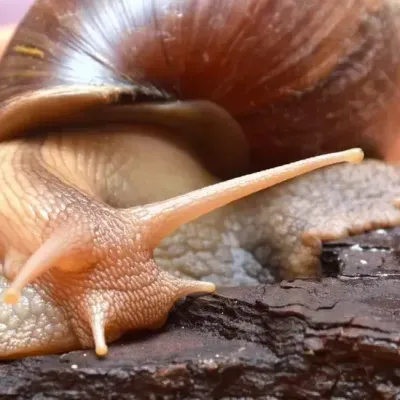 Border Cave - The molluscs have been a staple part of many diets for years, but puzzled scientists have been looking into a very important question - when exactly did humans start eating them? Well, it looks like they may have found the answer thanks to fragments of giant African land snail shells found at an archaeological site in South Africa. The new research suggests humans cooked and ate giant land snails 170,000 years ago, in what is the earliest find of its kind. The snail remains were found at the Border Cave site located on a cliff near South Africa's border with Eswatini. Border Cave is one of the oldest and most complete prehistoric sites in Africa. It's thought to have been lived in by humans for over 200,000 years and contains evidence of human activity dating back to the Middle Stone Age. The snail shells were excavated from the site between 2015 and 2019, and range in colour from beige to brown and even matt grey, which indicate the snails had been cooked before they were eaten. Previous research suggests humans began catching and eating giant snails about 35,000 years ago in Europe and 49,000 years back in Africa, with their consumption becoming more frequent among human populations between 14,000 and 10,000 years go. However, the scientists working on this latest study believe it shows people actually started eating the molluscs much earlier. The study suggests large African land snails were first brought to the 200,000-year-old site by humans in southern Africa about 170,000 years ago, with the popularity of this increasing between 160,000 and 70,000 years ago. "Terrestrial molluscs are an excellent source of nutrients, they are easy and not dangerous to collect, they can be stored for some time before being consumed, they are simple to prepare and to digest as long as one has a basic mastery of fire," the study says. This would have made the snails an ideal food source for humans at the time. "The easy-to-eat, fatty protein of snails would have been an important food for the elderly and small children, who are less able to chew hard foods," Marine Wojcieszak who worked on the study told Science News.
Border Cave - The molluscs have been a staple part of many diets for years, but puzzled scientists have been looking into a very important question - when exactly did humans start eating them? Well, it looks like they may have found the answer thanks to fragments of giant African land snail shells found at an archaeological site in South Africa. The new research suggests humans cooked and ate giant land snails 170,000 years ago, in what is the earliest find of its kind. The snail remains were found at the Border Cave site located on a cliff near South Africa's border with Eswatini. Border Cave is one of the oldest and most complete prehistoric sites in Africa. It's thought to have been lived in by humans for over 200,000 years and contains evidence of human activity dating back to the Middle Stone Age. The snail shells were excavated from the site between 2015 and 2019, and range in colour from beige to brown and even matt grey, which indicate the snails had been cooked before they were eaten. Previous research suggests humans began catching and eating giant snails about 35,000 years ago in Europe and 49,000 years back in Africa, with their consumption becoming more frequent among human populations between 14,000 and 10,000 years go. However, the scientists working on this latest study believe it shows people actually started eating the molluscs much earlier. The study suggests large African land snails were first brought to the 200,000-year-old site by humans in southern Africa about 170,000 years ago, with the popularity of this increasing between 160,000 and 70,000 years ago. "Terrestrial molluscs are an excellent source of nutrients, they are easy and not dangerous to collect, they can be stored for some time before being consumed, they are simple to prepare and to digest as long as one has a basic mastery of fire," the study says. This would have made the snails an ideal food source for humans at the time. "The easy-to-eat, fatty protein of snails would have been an important food for the elderly and small children, who are less able to chew hard foods," Marine Wojcieszak who worked on the study told Science News.
https://www.bbc.co.uk/newsround/65188805
TIBET – Gyelsang - Southwest China’s Tibet Autonomous Region has recently found the region’s hitherto earliest cave tomb dating back to over 3,000 years in Gyelsang cemetery site of Nedong District in Shannan City. The cave tomb was built around 1200 BC, according to carbon-14 dating data. A total of 40 ancient tombs, including cave tombs, stone tombs and earth-pit ones, were newly found at the site. They are believed to have been built between the 13th century BC and the seventh century AD during the reign of the Tibetan Tubo Kingdom. Relics such as pottery, woodware and stoneware were also uncovered. Among all the funerary objects, the majority were pottery in special shapes with distinct regional characteristics. The cemetery site is indicative of diverse cultures and exchanges and connections between different areas in the hinterland of Tibet at that time, said Tashi Tsering, a researcher with the regional institute of cultural relics protection. The prehistoric cemetery also provides evidence that central Tibet had formed a relatively stable cultural area as early as the Shang and Zhou dynasties (1600 BC-256 BC), the researcher added. In 2022, a joint archaeological team excavated the Gyelsang cemetery site, with the total excavation area covering about 300 square meters.
https://pakobserver.net/chinas-tibet-discovers-3000-years-old-cave-tomb/
NORVEGE – 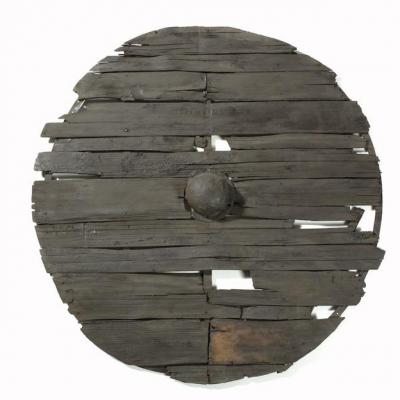 Gokstad - A new study suggests that the 64 wooden shields discovered in southern Norway’s Gokstad ship burial in 1880 were part of the ship’s equipment and may have been used in combat. It had been previously thought that the shields were solely ceremonial. Rolf Warming of the University of Stockholm said that the round shields, which had been tied along the top edge of the ship’s hull when it was repurposed for the burial of a Viking king in A.D. 900, were likely to have been covered with a thin layer of rawhide, based upon the organic material and stitching holes observed on the surface. The shields may have also been painted either yellow or black, he added, to create the look of yellow and black crescents when the shields were overlapped. Made from tapered wooden boards set around a center iron shield boss on one side and a wooden handle on the other, the shields would have been light and easy to maneuver in combat, he explained. Future research will focus on irregular notches and marks on the shield bosses and analysis of the organic material.
Gokstad - A new study suggests that the 64 wooden shields discovered in southern Norway’s Gokstad ship burial in 1880 were part of the ship’s equipment and may have been used in combat. It had been previously thought that the shields were solely ceremonial. Rolf Warming of the University of Stockholm said that the round shields, which had been tied along the top edge of the ship’s hull when it was repurposed for the burial of a Viking king in A.D. 900, were likely to have been covered with a thin layer of rawhide, based upon the organic material and stitching holes observed on the surface. The shields may have also been painted either yellow or black, he added, to create the look of yellow and black crescents when the shields were overlapped. Made from tapered wooden boards set around a center iron shield boss on one side and a wooden handle on the other, the shields would have been light and easy to maneuver in combat, he explained. Future research will focus on irregular notches and marks on the shield bosses and analysis of the organic material.
https://www.livescience.com/1100-year-old-ceremonial-viking-shields-were-actually-used-in-battle-study-suggests
ITALIE – 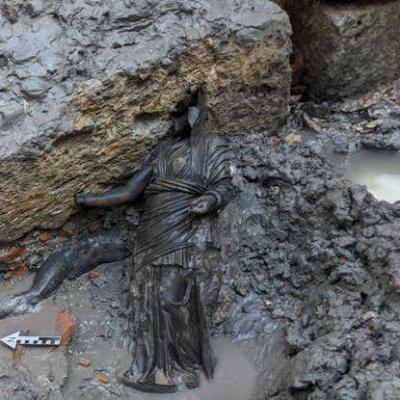
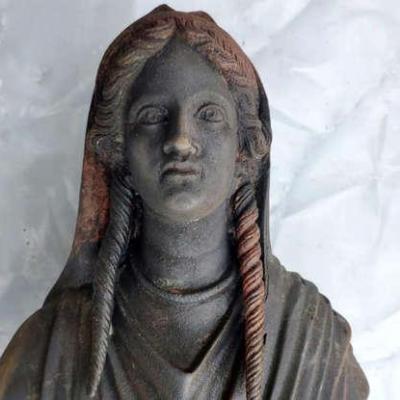
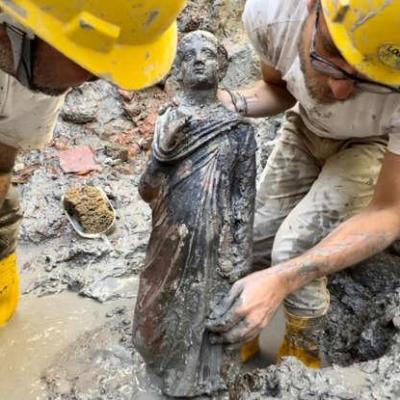 San Casciano dei Bagni - Dieux, matrones, enfants, empereurs. Protégé depuis 2300 ans par la boue et l’eau bouillante des bassins sacrés, il est ressorti des fouilles de San Casciano dei Bagni, dans la province de Sienne, un dépôt votif jamais vu auparavant. Avec des milliers de pièces de monnaie, 24 statues de bronze ont émergé, dont 5 mesuraient près d’un mètre de haut, parfaitement intactes. Un trésor « absolument unique », accompagné d’une quantité incroyable d’inscriptions en étrusque et en latin et auquel s’ajoutent des milliers de pièces de monnaie. Probablement réalisées par des artisans locaux, les 24 statues que l’on vient de retrouver peuvent être datées entre le IIe siècle av. J.-C. et le premier après. Les statues proviennent des grandes familles, des élites du monde étrusque puis romain. Propriétaires terriens, seigneurs locaux, classes riches de Rome et même empereurs. Étonnamment, la langue des Étrusques semble survivre beaucoup plus longtemps que les dates canoniques de l’histoire, tout comme la connaissance étrusque en termes de médecine semble être reconnue et acceptée comme telle même à l’époque romaine.
San Casciano dei Bagni - Dieux, matrones, enfants, empereurs. Protégé depuis 2300 ans par la boue et l’eau bouillante des bassins sacrés, il est ressorti des fouilles de San Casciano dei Bagni, dans la province de Sienne, un dépôt votif jamais vu auparavant. Avec des milliers de pièces de monnaie, 24 statues de bronze ont émergé, dont 5 mesuraient près d’un mètre de haut, parfaitement intactes. Un trésor « absolument unique », accompagné d’une quantité incroyable d’inscriptions en étrusque et en latin et auquel s’ajoutent des milliers de pièces de monnaie. Probablement réalisées par des artisans locaux, les 24 statues que l’on vient de retrouver peuvent être datées entre le IIe siècle av. J.-C. et le premier après. Les statues proviennent des grandes familles, des élites du monde étrusque puis romain. Propriétaires terriens, seigneurs locaux, classes riches de Rome et même empereurs. Étonnamment, la langue des Étrusques semble survivre beaucoup plus longtemps que les dates canoniques de l’histoire, tout comme la connaissance étrusque en termes de médecine semble être reconnue et acceptée comme telle même à l’époque romaine.
Incroyable découverte archéologique : 24 statues de bronze vieilles de 2300 ans émergent de l’eau et de la boue (msn.com)
INDE - Magalimedu - The third phase of excavations began on Thursday at Magalimedu village near Gangaikonda Cholapuram in Ariyalur district. Gangaikonda Cholapuram in Ariyalur was the second capital of the famous Chola Empire. This was established by King Rajendra Chola after his victorious expedition up to the Gangetic plains. Inscriptions indicate that during his reign large palaces were built here named Gangaikonda Chola, Thirumaligai and Chola Kerala. On the basis of the evidence of inscriptions, the Tamil Nadu State Department of Archaeology (TNSDA) took up excavation work from 2020-2022 at Maligaimedu village near Gangaikonda Cholapuram, and found brick structures, Chinese potteries and roof tiles, iron nails, ornate stones, copper and gold bracelet, bells, ivory carvings and coins. A large number of China potteries reveal trade relations between Tamil Nadu and China during the 11th and 12th centuries. The first phase of excavations was carried out from March to September 2021 at Maligaimedu near Gangaikonda Cholapuram. A total of 17 pits were excavated and a total of 1,003 items were recovered. Similarly, the second phase of excavations was carried out from February to September 2022 at Maligaimedu, where a total of 19 pits were excavated and a total of 1,010 items recovered.
https://www.newindianexpress.com/states/tamil-nadu/2023/apr/08/third-phase-of-excavation-begins-at-ariyalurs-maligaimedu-to-continue-till-september-2023-2563747.html
ANGLETERRE – 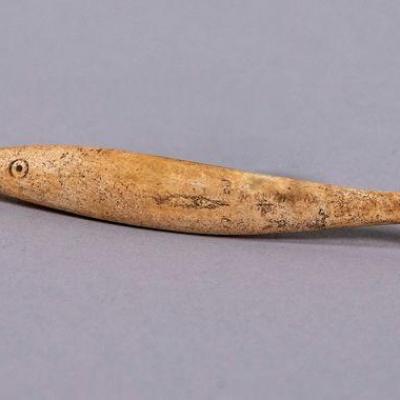 Westminster. - A 200-year-old fish figurine that may have been used in an old card game has been dug up under the Palace of Westminster. Researchers believe the intricately carved token, made from animal bone, may have been used in a game called "Lottery Tickets". The game, popular in the 18th and 19th centuries, and mentioned in Jane Austen's 1813 novel, Pride and Prejudice, involves two players attempting to match their cards to the values of those in the middle of a table. The winner of the round claims a fish token, like the one found by archaeologists. The find follows the discovery of a section of the original medieval Thames River wall, believed to run underneath the length of the Houses of Parliament. Medieval timber structures, thought to be part of a river defence system, were also discovered during an excavation of Black Rod's Garden in 2015.
Westminster. - A 200-year-old fish figurine that may have been used in an old card game has been dug up under the Palace of Westminster. Researchers believe the intricately carved token, made from animal bone, may have been used in a game called "Lottery Tickets". The game, popular in the 18th and 19th centuries, and mentioned in Jane Austen's 1813 novel, Pride and Prejudice, involves two players attempting to match their cards to the values of those in the middle of a table. The winner of the round claims a fish token, like the one found by archaeologists. The find follows the discovery of a section of the original medieval Thames River wall, believed to run underneath the length of the Houses of Parliament. Medieval timber structures, thought to be part of a river defence system, were also discovered during an excavation of Black Rod's Garden in 2015.
https://www.coastfm.co.uk/news/uk/200-year-old-fish-figurine-used-in-card-game
INDE – Kilnamandi - The Tamil Nadu State Department of Archaeology has begun the excavation of 'stone circles' at Kilnamandi village near Vandavasi in Tiruvannamalai. "The stone circles are indications of a burial ground that dates back to the Megalithic period (about 3000 years old). The diameter of stone circles ranges from 3-5 metres. There are hundreds of them in this site, which is spread over approximately 55 acres," Victor Gnanaraj, excavation director, told TNIE. Inside some of these stone circles, pieces of Sarcophagus (terracotta coffin) were also found. The excavation will help us analyse the site formation like signs of habitations in this region, understand the burial practice of the inhabitants, and situate other Megalithic sites in this region, he said. Other discoveries in this site include Iron Age pottery such as black and red wares and red slipped wares with graffiti marks which were found in the potsherds.
https://www.newindianexpress.com/states/tamil-nadu/2023/apr/07/state-archaeology-department-begins-excavation-of-stone-circles-at-kilnamandi-village-in-tn-2563427.html
SOUDAN – 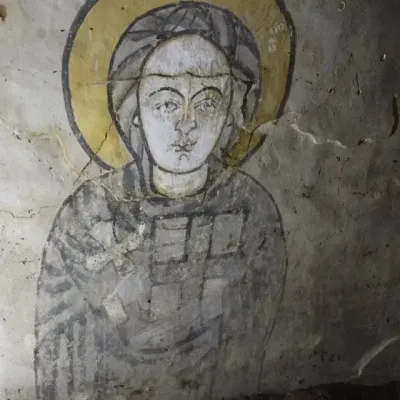
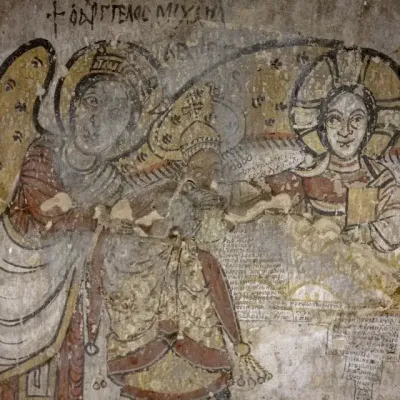 Old Dongola - Archaeologists of the Polish Center of Mediterranean Archaeology at the University of Warsaw discovered an enigmatic complex of rooms made of sun-dried brick, the interiors of which were covered with figural scenes unique to Christian art. The discovery was made at the Old Dongola medieval monastery on the banks of the Nile, more than 500 km north of Khartoum. Old Dongola (Tungul in Old Nubian) was the capital of Makuria, one of the most prominent medieval African states. It had converted to Christianity by the end of the sixth century, but Egypt was conquered by Islamic armies in the seventh century. An Arab army invaded in 651 but was repulsed, and the Baqt Treaty was signed, establishing relative peace between the two sides that lasted until the 13th century. The discovery was made during the exploration of houses dating from the Funj period (16th-19th century CE). Within the main monastic complex, the Polish mission unearthed now a second, well-preserved church with vivid mural paintings and inscriptions in Greek and Old Nubian. Surprisingly, beneath the floor of one of the houses was an opening leading to a small chamber with walls decorated with unique representations. The paintings inside depicted the Mother of God, Christ, and a scene with a Nubian king, Christ, and Archangel Michael. This was not, however, a typical depiction of a Nubian ruler under the protection of saints or archangels. The king bows and kisses the hand of Christ, who is seated in the clouds. The ruler is aided by Archangel Michael, whose spread wings protect both the king and Christ. Such a scene finds no parallels in Nubian painting. The representation’s dynamism and intimacy contrast with the hieratic nature of the figures depicted on the side walls. Similarly, the figure of the Virgin Mary on the north wall of the chamber does not fit into the standard repertoire of Mary depictions in Nubian art. The Mother of God is dressed in dark robes and strikes a dignified pose. She has a cross and a book in her hands. On the opposite wall, Christ is depicted. His right hand is shown in a blessing gesture, and his left hand is holding a book, which is only partially preserved.
Old Dongola - Archaeologists of the Polish Center of Mediterranean Archaeology at the University of Warsaw discovered an enigmatic complex of rooms made of sun-dried brick, the interiors of which were covered with figural scenes unique to Christian art. The discovery was made at the Old Dongola medieval monastery on the banks of the Nile, more than 500 km north of Khartoum. Old Dongola (Tungul in Old Nubian) was the capital of Makuria, one of the most prominent medieval African states. It had converted to Christianity by the end of the sixth century, but Egypt was conquered by Islamic armies in the seventh century. An Arab army invaded in 651 but was repulsed, and the Baqt Treaty was signed, establishing relative peace between the two sides that lasted until the 13th century. The discovery was made during the exploration of houses dating from the Funj period (16th-19th century CE). Within the main monastic complex, the Polish mission unearthed now a second, well-preserved church with vivid mural paintings and inscriptions in Greek and Old Nubian. Surprisingly, beneath the floor of one of the houses was an opening leading to a small chamber with walls decorated with unique representations. The paintings inside depicted the Mother of God, Christ, and a scene with a Nubian king, Christ, and Archangel Michael. This was not, however, a typical depiction of a Nubian ruler under the protection of saints or archangels. The king bows and kisses the hand of Christ, who is seated in the clouds. The ruler is aided by Archangel Michael, whose spread wings protect both the king and Christ. Such a scene finds no parallels in Nubian painting. The representation’s dynamism and intimacy contrast with the hieratic nature of the figures depicted on the side walls. Similarly, the figure of the Virgin Mary on the north wall of the chamber does not fit into the standard repertoire of Mary depictions in Nubian art. The Mother of God is dressed in dark robes and strikes a dignified pose. She has a cross and a book in her hands. On the opposite wall, Christ is depicted. His right hand is shown in a blessing gesture, and his left hand is holding a book, which is only partially preserved.
https://arkeonews.net/archaeologists-discovered-an-enigmatic-complex-of-rooms-interiors-of-which-covered-with-figural-scenes-unique-to-christian-art/